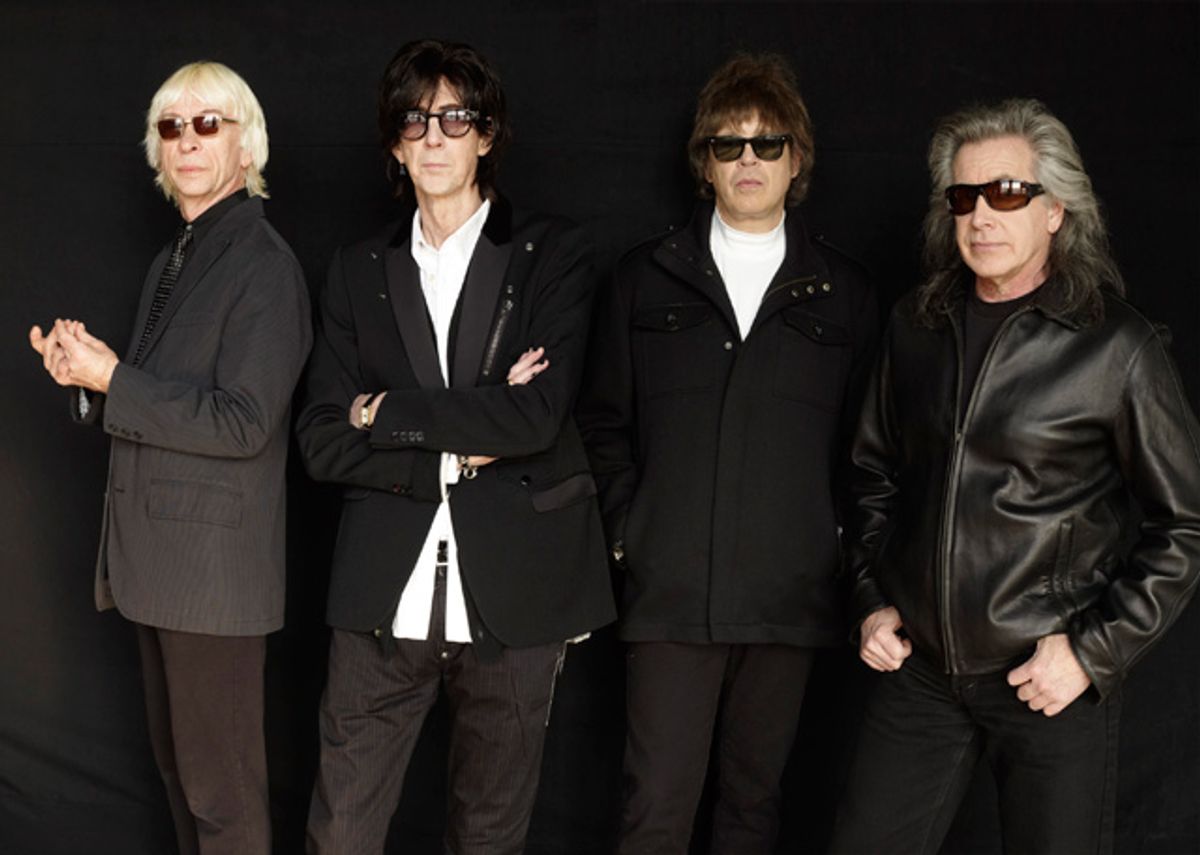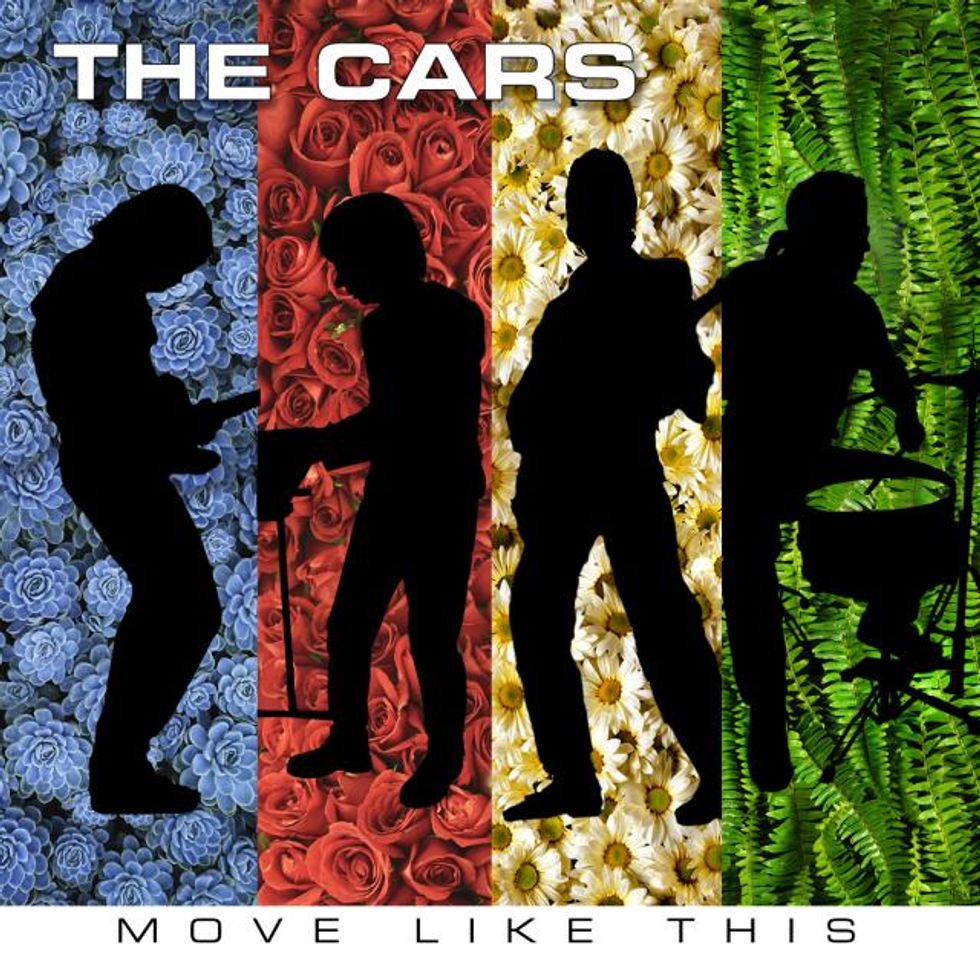
The Cars'' Elliot Easton talks about reuniting with his chart-topping new wave bandmates and using a bunch of guitars from his amazing collection to record their classic-sounding new album, Move Like This.
With the birth of MTV and the music video, the new wave movement took the ’80s by storm. One of the genre’s biggest acts was the Cars. Comprised of singer-songwriter and rhythm guitarist Ric Ocasek, bassist Benjamin Orr, keyboardist Greg Hawkes, drummer David Robinson, and lead guitarist Elliot Easton, the Cars dominated the charts throughout the decade with hits like “Just What I Needed,” “Shake It Up,” “You Might Think,” “Drive,” and many, many more.
Much of the Cars’ success can be attributed to its hook-laden hits, many of which were crafted by Easton. Easton, a southpaw guitarist, is one of the best at successfully integrating the guitar into a pop-rock context. He is known for tasty and reserved playing—adding parts that serve the song rather than an ego. Easton was trained at the Berklee College of Music and certainly has chops to spare, but his playing style shows off his taste and discretion more than his ability. “There was this punk ethic that if you had too much technique, you didn’t have any street cred. It was hipper and somehow cooler to thumb three chords out of tune. While I don’t necessarily share that view—though I do love simplicity and I love a primitive kind of playing—it’s about what’s behind it,” says Easton.
The Cars disbanded in February 1988. But in 2005, Easton and original keyboardist Greg Hawkes formed The New Cars, featuring Todd Rundgren as lead vocalist. This version of the Cars achieved modest success, but had to cancel their 2006 spring tour after Easton broke his collarbone. By 2007, the band broke up. In 2011, after a 23-year hiatus, the original members of the Cars (minus Benjamin Orr, who died of pancreatic cancer in 2000) reunited. The band’s latest album, Move Like This, was released by Hear Music/Concord Music Group this spring, and provides that unmistakable Cars sound again. We checked in with the affable Easton to get inside information on the reunion and the gear he used on the recording sessions.
Tell us how the reunion came about.
Well, close to two years ago I called Ric up. I hadn’t spoken to him in a while, but he’s an old friend and we just had a nice chat. I asked him what he’d been doing and he said he’d been writing songs. Ric was real happy with them and said they were different than some of his past ones. I said, "That sounds great—what are you gonna do with them?" He told me he figured he’d just make another solo record, and that’s when I asked him about making a new Cars record. Ric liked the idea, and after a few weeks he'd made some calls to Greg and David, who also thought it would be fun and agreed to give it a try.
What was the impetus for calling Ric that day?
You know, when it’s ready, it’s ready. When you can do it, you can do it. You don’t even know why you couldn’t do it before that. It’s also not like I’ve been out of touch with these guys—we talk and have business together.
What was that first session like, getting back together?
It was great and felt good from the get-go. Even before we started playing together again, we got together up at Ric’s house, and it just felt like the Cars. There was clearly a gap since Benjamin was missing, but it was still the old jokes and humor. It’s like getting together with old family members—within minutes you’re back to where you were. It had a feeling of an event about it, with the anticipation that we were gonna play again, and that we were coming together for this reason.
Did Ric send you the music ahead of time?
He did. Ric sent us some demos so we had ideas about some of the songs. We were familiar enough to at least start trying to play something.
Were the guitar parts already written or did you take the tracks and work with them before the first session?
A band is like a cooperative—you just kick ideas around until you think you’ve got the best arrangement. It works in many different ways. I might come up with a part, or there might be something suggested by the demo I pick up on. There might be a part on the demo that is clearly part of the song, and too important not to play. We also make suggestions to each other like, "What do you think of this? Can you change that?" We just kind of hammer it out.
 Where was the album recorded?
Where was the album recorded?Half was recorded at Millbrook Sound Studios in Millbrook, New York, and the other half was recorded at Village Recorders in Santa Monica. I live in LA, Ric lives in New York, and David and Greg live in the Boston area. So I flew into New York and David and Greg drove down from Boston. That first visit was maybe a week—not as complicated as it might seem.
Did you track your parts at home or did you do them all at the studio?
We did them all at the studio. There may have been some keyboard parts and other things from the demo—and Greg might’ve done some stuff on the computer—but I don’t remember exactly. I recorded everything in the studio.
What was your gear setup for the record?
On the west coast sessions, since I could drive there, I could bring more of my own stuff. For the east coast sessions, I just shipped a few guitars and a bunch of pedals along with my pedalboard. But Paul Orofino at Millbrook Studios has a fantastic collection of amps and it seems like he’s got one of everything—we could pick and choose whatever we wanted. It’s funny, though, because with all the vintage stuff that he had, we ended up mainly using the Fender Blues Jr. It’s like a tiny version of a Hot Rod Deluxe.
Just a stock Blues Jr.?
Yeah. For some reason, the Blues Jr. sounded amazing and we used that a lot, especially for the clean stuff. I also used a vintage Fender Vibrolux and an Ampeg Gemini. Paul has a bunch of heads in the control room that are mounted into the wall with a switch box, so you could try out any head easily. He also has two cabinet configurations, and I could switch between them. Along with these Marshalls, Hughes & Kettners, and all kinds of different amp heads Paul had in the control room, he had a whole collection of combo amps.
For the west coast stuff, I used a few different small amps of my own and Garret [producer Garret “Jackknife” Lee] had some amps, as well. I brought a handwired Vox AC15—the white one with a TV front and a Pentode/Triode switch. I also brought a reissue Princeton Reverb, a reissue Deluxe Reverb, and my Peavey Penta—that’s a wild amp. Garret had an old British AC30 that we used, along with an old Selmer. Though I don’t think we used the Selmer that much—he was having problems with that one.
What were the main guitars you used on the recordings?
The two main guitars were my signature model SG and a ’63 ES-335 Historic reissue. I used a Fender Custom Shop Nocaster, a white Fender Custom Shop ’66 Strat, and a Phantom Guitarworks 12-string. There’s my 6-string bass Strat from the Fender Custom Shop that’s like a Stratocaster, but it’s an octave lower. They built it for Dick Dale but he didn’t want it, so he gave it to me. It’s very cool. It’s like a blonde Mary Kay-looking thing, and it’s got a big, long neck on it—but it’s just a Strat. I also used a Martin HD-28V acoustic, and a white Mosrite Ventures model. I think that’s it!
How about cables, picks, and strings?
I’m a loyal D’Addario and Planet Waves man. On the Gibsons, I use .010 through .046—the regular 110s. And then, lately, on the Fender I’ve been using .0095s. They are between the .009s and .010s, and since they are a little lighter, I find them easier to bend with the longer scale.
How about pedals?
I’ll tell you what’s on the pedalboard for this Cars tour, if I can remember them all. It’s a big pedalboard. I’ve got a JangleBox compressor and a bunch of Line 6 stuff—a DL4, FM4, Echo Park, Verbzilla, Roto-Machine, and Tap Tremolo. For chorus, I’m using my old TC Electronic pedal, and I’ve got a Cry Baby wah-wah, a phaser, and a little Boss harmonizer.
What kind of pedalboard is it?
I had it built by Stompin' Ground—they’ll custom-build whatever you want. It has a case and wheels, and there’s room for other stuff in there. It’s powered underneath by two Voodoo Lab Pedal Powers.
You also worked with famed pedal guru Alfonso Hermida on the Tiki Drive. Can you tell us about that?
Alfonso sought me out a long time ago to try out the Zendrive—a great pedal—and we stayed friends. I have this pedal from Australia that I’m really crazy about called the MI Audio Crunch Box, and that pedal is the best “Marshall-in-a-box” distortion pedal that I’ve come across. I really love it—it’s got a great voice to it. So I asked Alf if he wanted to try to build something similar to the Crunch Box. The Zendrive is called a “Dumble-in-a-box” because it’s compressed and has a little different kind of tone to it. I asked him if he could do something that was more open sounding and more Marshall-y, while raving to him about this Crunch Box. He got one to check out, and Alf being Alf, did his own take on it. It’s a very different pedal than the Crunch Box. For one thing, it’s got two levels of gain—so you can dial it down to a nice overdrive, or you can dial it way up for great solo tones.
I understand that you have a collection of guitars for sale at Rudy’s Music in New York. Can you tell us about that?
I just prune the collection from time to time. I’ve got so many guitars, man. Once in a while, I just get rid of some, even though I’ve already taken most of them back.
Are there any guitars that you will never let go of?
There’s a couple there that I have to get back [laughs]. It’s not the best time to sell guitars, because of the economy anyway, so I’d rather hang on to them. I have a left-handed ’61 Barney Kessel custom with PAFs that I don’t think I would ever sell. I’m actually thinking of taking a couple more back from Rudy’s. I had a mint-condition 1965 ES-335 with a factory Bigsby and I just couldn’t stand it, man. I had him send it back. It was eating away at me.
Elliot Easton’s Gearbox
Guitars
Gibson Elliot Easton Signature SG, Gibson ’63 ES-335 Historic Reissue, Fender Custom Shop Nocaster, Fender Custom Shop ’66 Stratocaster, Phantom Guitarworks 12-string
Amps
Vox AC15, Fender 1965 Princeton Reverb reissue, Fender 1965 Deluxe Reverb reissue, Peavey Penta
Effects
Line 6 DL4 Delay Modeler, Line 6 FM4 Filter Modeler, Line 6 Echo Park, Line 6 Verbzilla, Line 6 Roto-Machine, Line 6 Tap Tremolo, TC Electronic Stereo Chorus, Dunlop Cry Baby wah-wah, Boss harmonizer, custom Stompin' Ground pedalboard, two Voodo Lab Pedal Powers
Strings
D’Addario .010s or .0095s, depending on guitar
